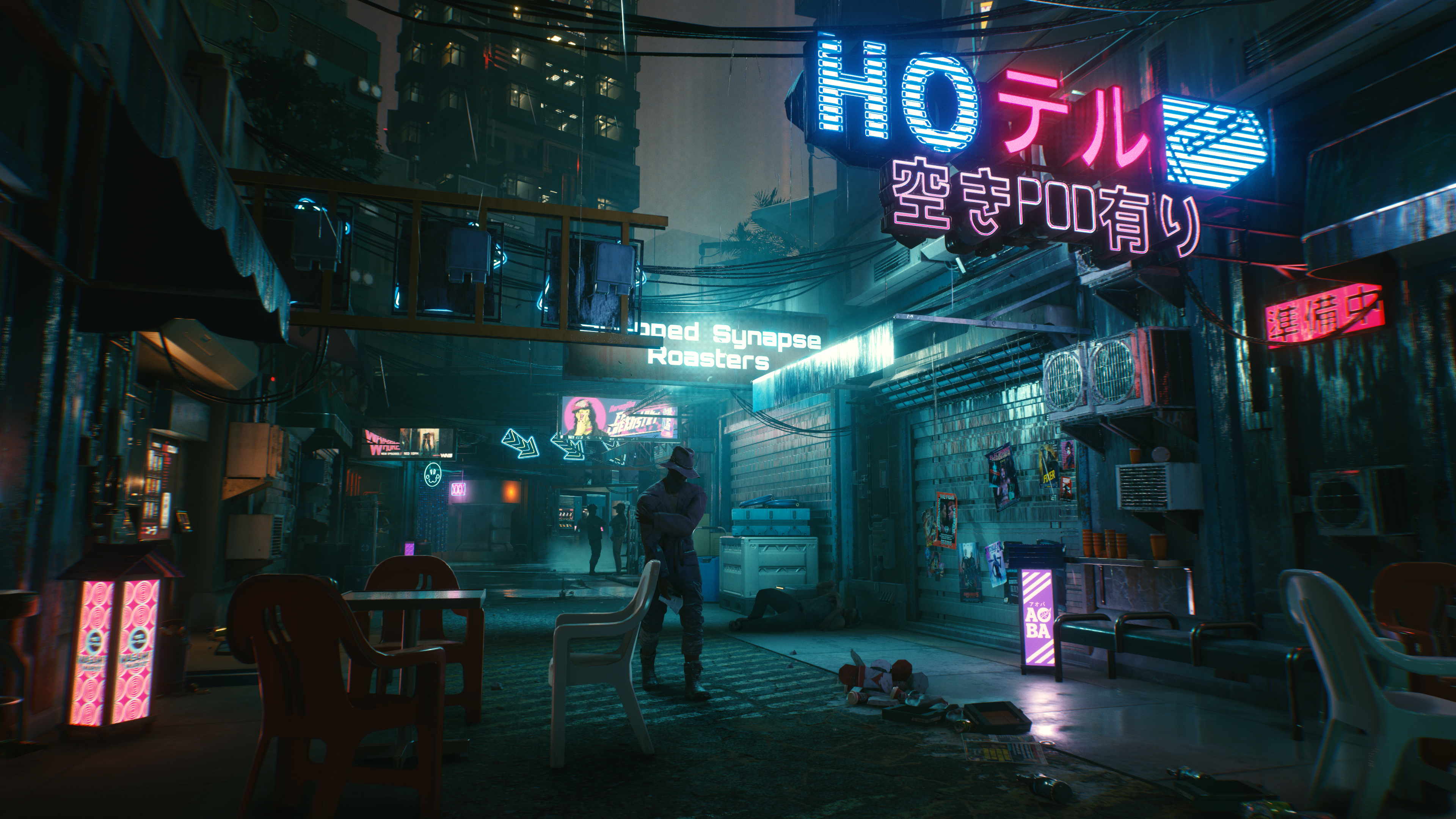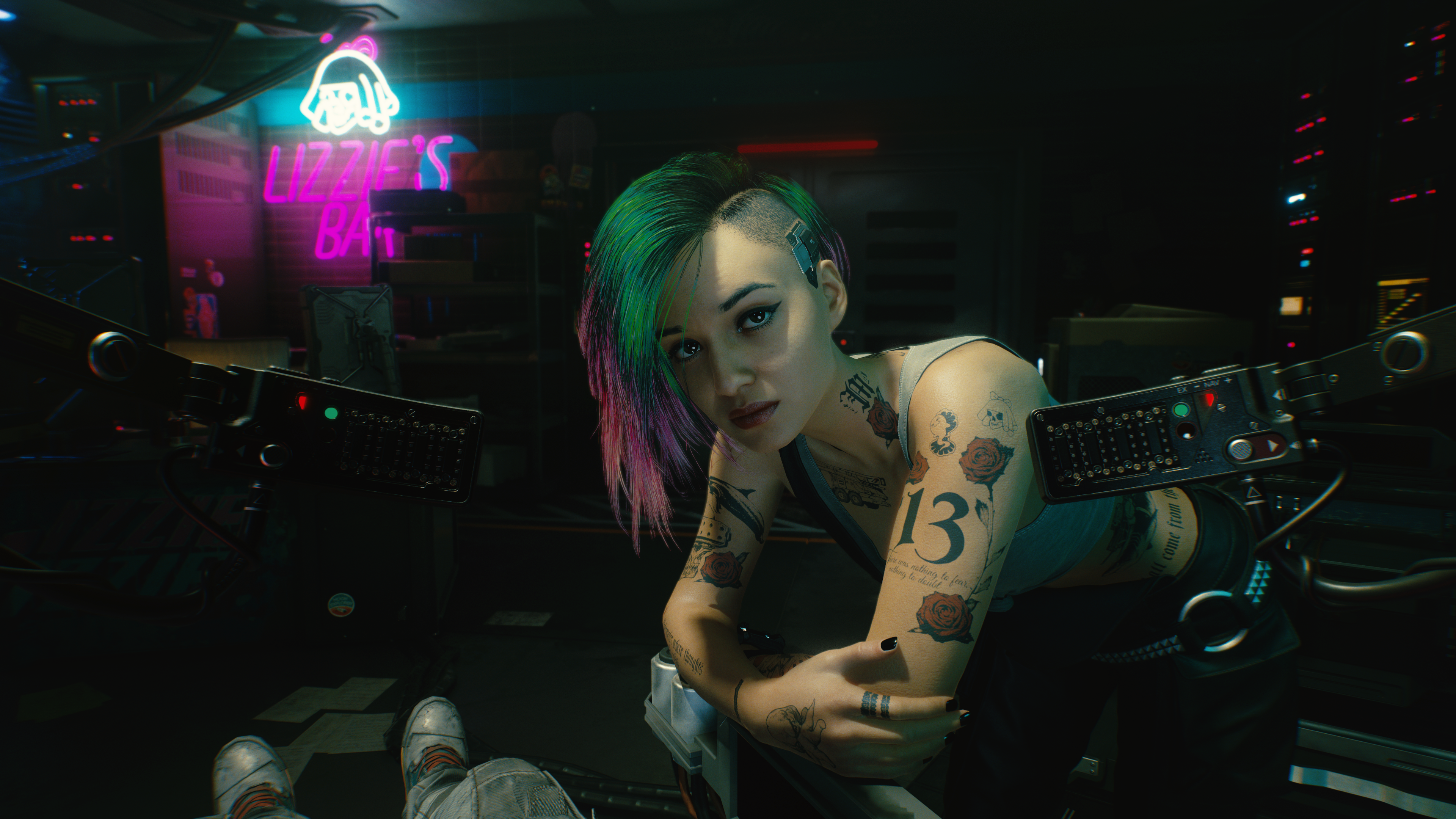This is the nature of Night City, the setting of Cyberpunk 2077, CD Projekt’s latest massive RPG. People hop into full-immersion virtual reality headsets containing snuff movies, recorded through the cybernetically-enhanced eyeballs of the victims. If that’s not your thing, the same vendors will be happy to load up some porn. Naturally. Night City is a shithole, but it’s a beautiful shithole. Neon blares from every building and billboard, while smokey streets give way to back alleys crammed with stores selling licit gear or unlicensed doctors who’ll provide an illegal, hacked augmentation for the right price.
In video game design terms, Night City owes a lot to Grand Theft Auto and other city-based open-world games. Like many elements of Cyberpunk, it appears CD Projekt looked at what other studios had accomplished and decided to try to do the same thing, but better, with its own twist. Night City is in many ways the true lead character of Cyberpunk - and so you’re turfed out onto its streets and set free to do whatever you want from very early in the game. As you hit the streets, the nature of Cyberpunk 2077 is truly driven home: as opposed to being something entirely earth-shattering and all-new, it’s an exciting a mash-up of a lot of different elements of a lot of different games. This isn’t a bad thing. There’s no need to reinvent the wheel to create a classic game - The Witcher 3 is similarly built atop its predecessors and rivals, after all. So there’s that GTA influence, but once you step off the city streets into more enclosed spaces designed for combat and stealth, things begin to resemble Deus Ex or Dishonored. Nattering away to NPCs reveals a BioWare storytelling streak, albeit one that clearly takes lessons and makes improvements on some of those ideas and similar execution in The Witcher. At other times the towering influence of The Elder Scrolls can be felt, even over such a vastly different universe. None of these things are a problem because all of those games are excellent. So too are those first four hours of Cyberpunk 2077: it’s a blistering whistle-stop tour of mechanics and ideas borrowed from excellent peers, layered atop a rich world that accomplishes that difficult feat of being a character in its own right. What do you get when you mash together a bunch of Good Shit from other games? In this instance the result is Real Good Shit.
Even on a strict time limit with this build of the game, I find myself lingering to take in the detail. You get drawn in, walking off the beaten path to ogle the ‘Hishou Panzer’ and ‘Roach Race’ arcade cabinets stuffed in the corner of a bar, or slowing the car to take in exuberant billboards. Heading up to protagonist V’s apartment requires a quick trip in an elevator. After jabbing the floor I want on the functioning touchscreen inside, I turn my gaze to screens inside the elevator, blasting out a TV stalk show. I stand and watch as guests are introduced and the show gets underway long after the elevator doors open, but I have to get moving - this is a limited-time hands on. The same was true of the character creator, which surprisingly blasts you with full-frontal nudity within a few button presses - there’s a wealth of options right down to what you what your V’s teeth to look like - but in this controlled environment, I zip through it. Regardless, this is the beauty of the world that CD Projekt has crafted - detail is everywhere - and it all serves to further immerse and teach the player more about Night City. Out on the streets, Cyberpunk feels more like a ’typical’ open-world action game. As you cruise around icons become visible on your mini-map, or contacts might text leads to your in-game phone. The map icons usually refer to events in progress - crimes that can be stopped or gang outposts that can be broken up. At one point I find police crowded around an alleyway, tending to wounded - down the alleyway, a powerful augmented individual on a killing spree, cornered and in a stalemate with the cops. If you choose, you can wade in and help out. You can also use a retina implant to scan citizens - some are wanted by the NCPD, and can be turned in for a bounty. Beyond all of this there are more traditional RPG side quests, with all the talky stuff you’d expect in the preamble. Traveling around Night City is a joy because of how it looks and feels - it oozes cool - but also because of what there is to do. I found a couple of slick combat encounters just by pulling over and exploring an area. These encounters have clearly been designed for multiple approaches - so there’s cover at the front for guns-blazing, routes around the rear for stealth, and hacking options for subterfuge and distraction - all on a dialogue-free side combat scenario. In fact, the only element I was less of a fan of was driving itself - V’s Quadra car is cool-looking but has a heavy, chunky sort of handling I’m just not big on - but you can at least ditch the car to walk as often or as far as you like. You can also summon your vehicle to your side with a single button press, which brings it silently cruising back to you like Kitt from Knight Rider. It doesn’t appear to pull a roach and end up on a rooftop, either. Handy!
When things do escalate, the shooting is good. This is still a role-playing game, with stats and rolls determining damage numbers and critical hits, but the gunplay is tight and responsive. Headshots do enough bonus damage that they feel significant, and body parts are spectacularly removed from executed enemies. Put simply, Cyberpunk feels like a legitimate shooter. Little touches, like how V naturally leans around corners when you aim down the sights and move the stick to peek out from cover when hidden, make the combat click as a truly action-led system - even though the stats under the hood remain all important. The first few hours of the game are too early to toy with some of the advanced skills already shown off in past trailers, but it does give a chance to get to grips with the basics. Pistols, rifles and shotguns are all satisfying to use, with weapon mods giving great RPG boosts that can impart a higher DPS, status effects or other bonuses. There’s of course a constant flow of loot split into the usual color-coded RPG categories, Melee is simple but fun - one trigger to block, another to swing, with tapping or holding determining the strength of the swing. There is, of course, a parry. Despite using a katana for a grand total of one combat encounter in this demo, I can already clearly see the path to a katana-led build in my mind - and that sort of option is cool. Speaking of options, Cyberpunk is full of them. Combat is an optional affair thanks to stealth - you can even play non-lethally. On the other hand, I managed to skip a difficult boss encounter I’d seen as part of an E3 demo by blasting said boss in the face in the middle of a conversation. That’s what I call conflict resolution. It’s not all about shooting and slicing, obviously. While I made the decision to cut that one conversation short with a bullet, there’s plenty of opportunity to natter to the residents of Night City. Generic NPCs will just grunt their designated line back at you, but others will trigger full-blown conversations. These characters seem interesting with the potential to be quite layered, though four hours isn’t enough time to get to know anyone properly, not even Jackie, the guy we’ve seen as V’s right-hand man in most footage so far. Options in blue are the ‘investigative’ queries that won’t advance the conversation but allow you to push deeper on an individual topic, while yellow options push things on. Every now and then options will appear specifically based on your stats, such as understanding technology better thanks to one RPG stat. Your ’life path’ origin story plays a role here, too - so a Corpo origin will know more about the inner workings of Night City’s shady corporations and be able to comment with that knowledge.
These various story branches are brimming with potential to have a significant impact on the story players experience. It’s always impossible to tell how this sort of choice pans out until we can enjoy a game in full, but the one major mission I played apparently has four key outcomes with a range of smaller variables beneath that - and each of these options later ripples on to impact multiple factions and story threads within Cyberpunk down the line. That’s exciting. As well as shooting, chatting, exploring, shopping, looting and all that other RPG stuff there’s also those VR experiences, known as ‘Braindance’. The snuff film mentioned in the opening of this article is one of those. These aren’t just videos to watch - they’re interactive experiences akin to the ‘Detective’ sequences in games like Batman Arkham and The Witcher turned up to eleven. You get the chance to explore a small stretch of time for as long as you like, manipulating time and scanning the environment for clues that might help in missions. I can see myself getting lost in it for hours. Inside a Braindance is one of the places you can really zero in on what appears to make Cyberpunk 2077 so exciting thus far: detail. Its world is disgracefully cool. It bleeds neon, but knows that its own street cred comes at a price - it is a world that is as corrupt as it is flashy, as broken as it is exciting. This hands-on went some way to calm any worries I had about Cyberpunk - like its combat might not be up to scratch, for instance. It also helped to reaffirm what I’d hoped - that the people behind The Witcher 3 might somehow have another potentially generation-defining hit in them. But more than that, it showcased that CD Projekt knows what it’s doing with this world. It’s a place where I already think I’ll be happy spending a good 100-plus hours. And d’you know what? I think I’ll probably end up doing just that. Cyberpunk 2077 releases for PC, Xbox One and PS4 in November. Next-generation and Stadia versions will follow before the end of the year.


